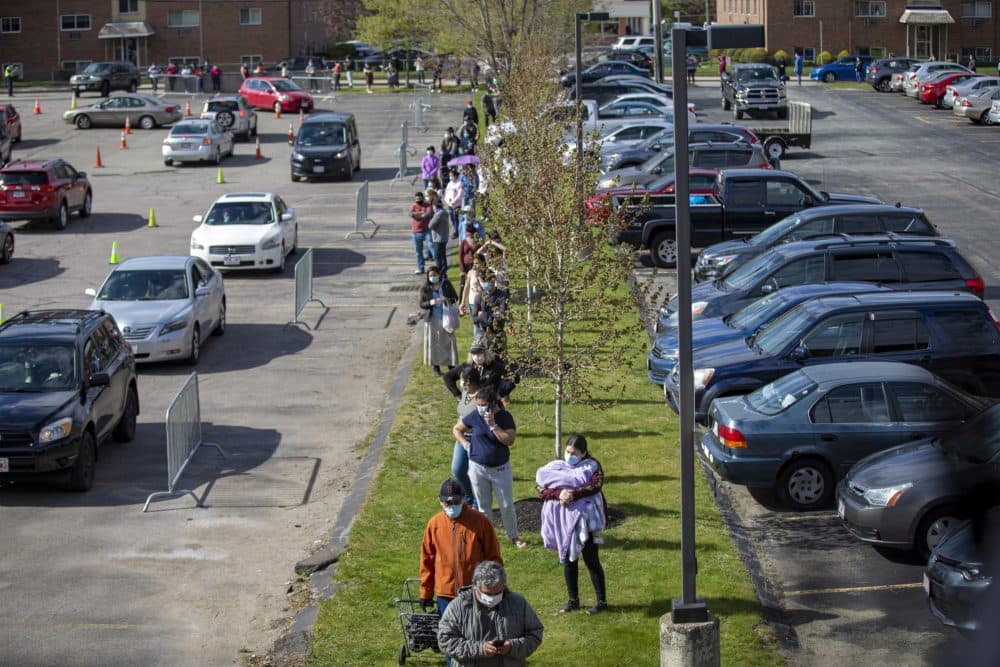Advertisement
Coronavirus Coverage
By The Numbers: What We've Lost, A Year Into The COVID-19 Pandemic

Today marks one year since Massachusetts declared a state of emergency across the commonwealth due to the ongoing coronavirus pandemic.
Calculating its brutal toll — from lives lost, to its devastation on the nation's economy and feeling of social connection — is nearly impossible to quantify. We are still living this in real time.
That said, there are some numbers we thought would be worth sharing to capture this precise moment — one year into this evolving and complicated reality — and bring us a little closer to understanding what we face and what may be gone for good.
It feels important to begin with death. As the numbers ticked steadily upward — with hardly a nation, state or city spared from at least one, if not several, surges — the figures are both stark and a callous accounting of lives lost.
Around the time the U.S. marked half a million COVID-19 deaths NPR talked to a psychologist about psychic numbness and why many people might be experiencing it through the pandemic — especially when thinking about statistics and how to feel about what they mean for society.
These were the lives lost, around the world, in our nation and in our state.
Worldwide: 116.8 Million Cases, 2.5 Million Deaths
As of March 9, there were at least 116,874,912 cases and 2,597,381 deaths reported across the world since the pandemic began, according to the World Health Organization’s COVID-19 dashboard.
U.S.: 28.9 Million Cases, 524,000 Deaths
As of March 9, there were at least 28,937,762 cases and 524,695 deaths since the pandemic began, according to the U.S. Centers for Disease Control and Prevention. You can use this NPR tool to see how severe outbreaks are in specific states.
Massachusetts: 560,000 Cases, 16,000 Deaths
As of March 9, there were at least 560,981 cases and 16,094 deaths in Massachusetts since the pandemic began, according to the state Department of Public Health. To better understand the virus' trajectory here, view our interactive maps and charts.
There were many ways the health of the nation was affected by the virus. There are COVID patients who didn't wake up for weeks after being put on ventilators, and many people continue to suffer so-called COVID long-hauler symptoms. People from all walks of life — and for many different reasons — experienced new or worsening mental health crises. And eventually, we saw a startling shift in the nation's overall predictor of individual longevity.
77.8
Dropping a full year since 2019, 77.8 years is now the new life expectancy at birth for the total U.S. population, according to the National Center for Health Statistics. The data is based on tracking the first half of 2020. As NPR reported: “For males, the life expectancy at birth was 75.1 – a decline of 1.2 years from 2019. For females, life expectancy declined to 80.5 years, a 0.9 year decrease from 2019.”
40%
Throughout the pandemic, several studies have shown that rates of anxiety and depression have risen dramatically in the U.S. Last June, a CDC study showed that 40% of American adults reported mental health or substance use struggles. By last November, the CDC had also said that 1 in 4 young adults — ages 18-24 — reported suicidal ideation within the previous 30 days. WBUR's On Point recently discussed the pandemic's impact on our collective mental health.
0.46%
After those terrible statistics, if you're looking for even the thinnest silver lining, COVID precautions appear to have resulted in this positive figure. Last week, the percent of hospital visits for influenza-like illnesses visits in Massachusetts was 0.46%, compared to nearly 4% in early March 2020. The U.S. has seen record low flu rates across the country this season, along with a record number of flu shots.
The beginning of the pandemic saw an absolute crush of layoffs and business closures that sparked a dramatic rise in unemployment claims and other critical social aid. While there has been some recovery in Massachusetts and elsewhere, the numbers continue to paint a bleak portrait of many people in dire need of work, housing or financial assistance.
151,727
In Massachusetts, 151,727 people remain unemployed, according to the latest numbers from the U.S. Department of Labor for the week ending Feb. 20. Though the number has been declining in recent months, it is still much higher than pre-pandemic levels. In February 2020, just over 100,000 residents were unemployed. Unemployment peaked in Massachusetts at the end of May, when almost 600,000 workers were unemployed, according to the Department of Labor. (Note: These figures represent traditional unemployment insurance claims and do not include gig workers and other nontraditional filers who have been able to claim some benefits amid the pandemic.)
181,423
Massachusetts workers filed 181,423 new unemployment claims the week of March 28 — the most filed in a single week since the pandemic began. March signaled the beginning of mass layoffs, as businesses across the commonwealth began to shut down.
175,800
Massachusetts has lost about 175,800 workers in its civilian labor force in the past 12 months, according to the Boston Federal Reserve, meaning those tens of thousands of people are no longer able to work or have stopped actively looking for work.
Nationally, women have left the workforce at a much higher rate amid the pandemic. NPR reports that 865,000 women in the U.S. dropped out of the workforce in September 2020 alone.
400%
In March and April 2020, there was roughly a 400% increase in the number of applications for Supplemental Nutrition Assistance Program (SNAP) benefits, or what's formerly known as food stamps, compared to the same period in 2019, according to the Department of Transitional Assistance. As of January 2021, about 534,722 households were receiving SNAP benefits, DTA said.
Last week, Massachusetts received federal approval to expand its Pandemic EBT (P-EBT) program to households with children under age 6 who also receive SNAP benefits — about 96,000 children — according to the Baker administration. The P-EBT program provides additional food assistance and was created to help families who previously depended on schools to provide reduced cost meals.
112 Million Pounds
Since last March, Greater Boston Food Bank says it has given out more than 112 million pounds of food to families in need, or almost 94 million meals. That total marks the largest 12-month distribution period in the food bank's 40-year history, and a 56% year-over-year increase.
“The pervasiveness of this pandemic has resulted in the worst of times for many and has deepened an already existing public health problem of food insecurity in the country," food bank President and CEO Catherine D’Amato said in a statement. "For all the wrong reasons it has allowed us to align in ways we never thought possible. It has given us both the courage and the personal and political will to accelerate our capabilities to address the problem of hunger with fortitude and transformed commitment.”
1,789
Since March 15, there have been 1,789 eviction filings in Boston, according to Princeton University’s Eviction Lab. A statewide moratorium largely put filings on hold from March 17 to mid-October 2020, but filings ratcheted back up in the fall, continuing to rise until a recent peak around the turn of the new year. Filings were at their highest the week of Dec. 27 to Jan. 3.
$2,336
Despite the economic downturn, rent in one of the most expensive metro areas in the country did not decline. The fair-market rent for a two-bedroom apartment in the Boston-Cambridge-Quincy area in 2021 is $2,336, according to the U.S. Department of Housing and Urban Development. That’s up $25 from $2,311 in 2020. One-bedroom apartments rose from $1,900 to $1,924 and four bedrooms rose from $3,131 to $3,168.
61,469
There were 61,469 single-family homes sold in 2020, the most in a year since 2004 and a 3.9% increase from the year prior, according to The Warren Group.
60%
In mid-April, at their lowest, statewide auto traffic volume was down by about 60% compared to the year prior, according to the Department of Transportation. The most recently available estimates for the last two weeks of February show that traffic is still down by about 10-35% overall compared to the same period in 2020, but by how much varies greatly across regions.
26%
In October 2020, MBTA ridership was just 26% compared to the year prior, the agency said, at 330,000 daily trips.
Perhaps one of the most contentious debates through the pandemic has been how best to handle in-person schooling. Through navigating closures, reopenings and virtual learning models, parents, teachers and school leaders have weighed the impacts on children and surrounding communities. Though state leaders and some health experts believe the virus' spread is lower among children, there still have been thousands of cases at Massachusetts public schools. And the coronavirus has taken its toll on education in many other ways too, from drops in enrollment to fewer child care options.
11,087
As class resumed this fall, the state's Department of Elementary and Secondary Education instructed public schools and school districts to report cases of COVID-19 among students or staff who had been inside school buildings in the seven days before they tested positive.
As of March 4, 2021, DESE's data recorded 11,087 total cases: 6,788 among students and 4,299 among staff. That number doesn't include anyone who contracted the virus while working or studying entirely from home — and neither does it prove that the virus was necessarily transmitted in school.
A wide array of school districts reported high numbers of cases: from noted urban epicenters like New Bedford (363) and Fall River (246) to smaller suburban districts like Milton (147) and Winchester (102). About 1 in 20 students in the Nahant Public Schools has tested positive for COVID-19 since September.
6,100
As of February, the state had issued at least 6,100 emergency teaching licenses. These licenses only require that a person is "of sound moral character" and has a bachelor's degree. The state worked with the Massachusetts Teachers Association to create this program as a way to help schools fill staffing shortages. To get a regular teaching license, people have to pass a set of tests known as the MTELs.
8,642
From preschool to postgraduate study, the pandemic altered thousands of families' education plans. But the effect was most acute at the state's 15 community colleges, which saw 8,642 fewer students enroll in the fall of 2020 than in the fall of 2019 — an 11% decline in a single year.
In past periods of high unemployment, community colleges have thrived. But not this time — or not yet.
Federal data show that far fewer families in the state's urban and low-income school districts are even applying for financial aid.
"This recession is really different," said Jim Mabry, president of Middlesex Community College. "It’s pandemic-driven, not economically driven. And it's gutted the economy from bottom up."
The past year's enrollment drop capped an eight-year decline within community colleges. And now their leaders and advocates are urgently seeking state or federal aid to rebuild reliable streams of new students starting next fall.
83%
That's the number of licensed child and after-school care providers which have reopened following state-mandated closures in March 2020. That translates into 30,000 fewer available seats for child care and after-school programs.
11,657
There are 11,657 children currently on waitlists for child care and after-school programs. Many families have requested care for their students during remote learning days at school. Large after-school providers have become remote-learning hubs for students to log into their classes during the day.
From dining to live music, the people and places in the arts and culture sector have been hit particularly hard by the pandemic, as so much of their revenue relies on in-person experiences. Thousands of restaurants in the state have closed, longstanding community staples have shut their doors and countless events and celebrations have been put on hold — or canceled altogether.
$588 Million
Earlier this month, the Massachusetts Cultural Council reported that the state's nonprofit and municipal cultural organizations have lost $588 million in revenue since March of last year. The council gathered the data from 981 cultural organizations and 3,000 individuals, along with financial and employment data.
3,400
On March 17, the state closed all indoor dining at its roughly 16,000 restaurants. Some were able to pivot to outdoor dining on June 8, and indoor dining did not resume at restaurants until June 22. During that time, about 3,400 restaurants closed their doors. Bob Luz, president of the Massachusetts Restaurant Association, said it's unlikely they'll reopen.
7
That’s the number of music venues in Greater Boston that closed their doors during the pandemic. Great Scott and Wonder Bar in Allston, Once Lounge & Ballroom, Thunder Road and Bull McCabe’s in Somerville, Machine Nightclub in Boston and the Milky Way Lounge in Jamaica Plain all announced that they would not reopen once live music is allowed to resume. An eighth location, the beloved Cantab Lounge in Cambridge went up for sale in July and faces an uncertain future. (Anyone want to buy it?) There are a few rays of hope, however: Once proprietor JJ Gonson has kept the brand alive through virtual concerts, leaving the door open for a new brick and mortar location someday. And Great Scott’s former talent buyer is trying to resurrect the club at the Allston Depot, which until recently was the home of a Pizzeria Regina.
2
So far, the pandemic has caused Bostonians to miss two in-person Boston marathons.
Countless Festivals, Parades And Community Events
To name just a few local ones:
- Boston Gay Pride parade
- Boston's St. Patrick's Day parade
- Boston's annual J'ouvert carnival parade and festival
- North End Italian feasts and processions
- Chinese New Year
- Fourth of July featuring the Boston Pops concert and fireworks show
- The Big E
- Topsfield Fair
With reporting from WBUR's Max Larkin, Carrie Jung, Kathleen McNerney, Amelia Mason and Roberto Scalese.

